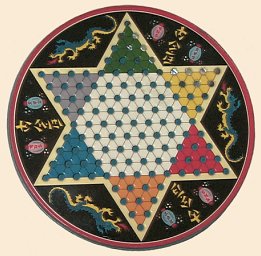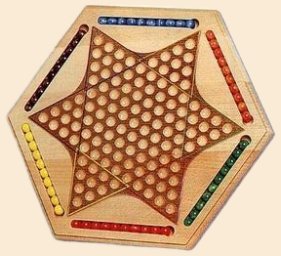|
The
Rules of Chinese Checkers
Equipment
The Chinese Checkers board is in the shape of a six pointed star. Each
point of the star is a triangle consisting of ten holes (four holes to
each side). The interior of the board is a hexagon with each side five
holes long. Each triangle is a different colour and there are six sets
of ten pegs with corresponding colours.
Preparation
Chinese Checkers can be played by two, three, four or six players.
Obviously, for the six player game, all pegs and triangles are used. If
there are four players, play starts in two pairs of opposing triangles
and a two player game should also be played from opposing triangles. In
a three player game the pegs will start in three triangles equidistant
from each other. Each player chooses a colour and the 10 pegs of that
colour are placed in the appropriately coloured triangle.
Objective
The aim of the game is to be the first to player to move all ten pegs
across the board and into the triangle opposite.
Play
A toss of a coin decides who starts. Players take turns to move a
single peg of their own colour. In one turn a peg may either be simply
moved into an adjacent hole OR it may make one or more hops over other
pegs. Where a hopping move is made, each hop must be over an adjacent
peg and into a the vacant hole directly beyond it. Each hop may be over
any coloured peg including the player's own and can proceed in any one
of the six directions. After each hop, the player may either finish or,
if possible and desired, continue by hopping over another peg.
Occasionally, a player will be able to move a peg all the way from the
starting triangle across the board and into the opposite triangle in
one turn!
Pegs are never removed from the board. It is permitted to move a peg
into any hole on the board including holes in triangles belonging to
other players. However, once a peg has reached the opposite triangle,
it may not be moved out of the triangle - only within the triangle.
Finishing
The first player to occupy all 10 destination holes is the winner.
Debate has always arisen over the situation where a player is prevented
from winning because an opposing player's peg occupies one of the holes
in the destination triangle. Many game rules omit to mention this
implying that it is perfectly legal to block opponents in this dubious
fashion.
Masters Games suggests the following additional rule which should be
wide enough to capture all such situations: If a player is prevented
from moving a peg into a hole in the destination triangle because of
the presence of an opposing peg in that hole, then instead of playing
in the usual way, the player is entitled to swap the opposing peg with
that of his own peg.
Alternatively, you can just say that should one or more of the holes in
the target triangle contain a peg belonging to another player, this
does not prevent a player from winning. The game is simply won when all
the available points within the triangle are occupied.
Copyright © 1999 Masters Games. All rights
reserved.
The rules are provided by Masters Traditional Games, an Internet shop selling games. Quote: "You are welcome to print, copy or pass these rules on but only in their original form including the copyright and the information about Masters Traditional Games."




Images from AbstractStrategy.com
![]()
|
© 2004 - 2006 Vegard Krog Petersen |
Home
History
Rules
Variations
Online
Freeware
Trialware
About
Links

 Chinese Checkers
Chinese Checkers